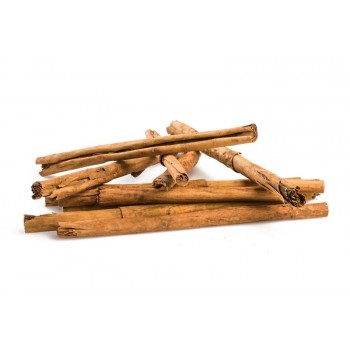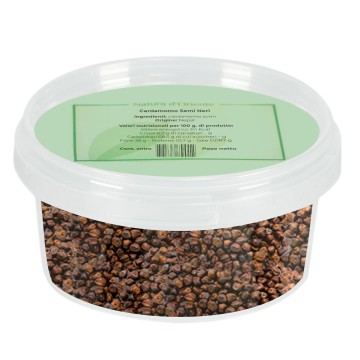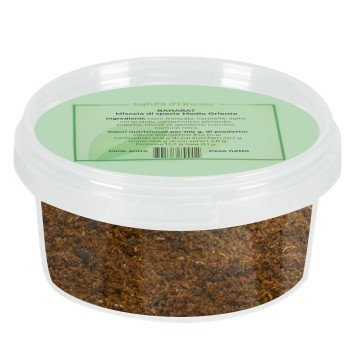This plant, known both as finocchiella and wild fennel, has all the edible parts (stem, seeds, flower, etc.). The fennel seed is appreciated in cooking, and in reality represents its fruit. The dried seeds are useful both in gastronomy and in herbal medicine.
In cooking they give a sweet and herbaceous flavor similar to dill and anise; an intense, fresh scent, reminiscent of licorice. It is a widespread ingredient in the Mediterranean tradition to flavor many dishes.
Fennel seeds are also used for well-being, given their antioxidant and digestive properties. In herbal medicine, the use of wild fennel seeds is widespread for the preparation of herbal teas useful for correct digestive function, to promote gastrointestinal motility and avoid constipation. They also help in the elimination of excess gas, and against irritation of the digestive system. Wild fennel seeds, especially in herbal tea, also provide benefits for purification, stimulating diuresis and the drainage of excess fluids. It promotes the relaxation of the abdominal muscles, avoiding discomfort during the menstrual period. Furthermore, the phytoestrogens contained in the seeds are suitable during menopause. Their composition allows you to obtain minerals such as calcium and copper.
Use of wild fennel seeds in cooking
The intense and sweetish flavor evokes anise, with the delicate but decisive aroma make these seeds a widespread aromatic spice in cooking. Compared to fennel seeds, the aromatic flavor of fennel is less sweet and stronger, but overall soft. It adapts in a versatile way to sweet and savory preparations, baking and liqueurs.
Fennel seeds or finocchietto, are known especially in the cuisine of central-southern Italy, used to perfume and flavor local dishes. They can be used whole or ground at the moment, to preserve the characteristics; also lightly toasted in a pan to enhance the aroma.
Meat: the aroma of wild fennel seeds is perfect on pork, lamb, all white meats, for some red meats and tartare. The seeds are used to create wild fennel meatballs, and in delicatessen for the preparation of sausages and cured meats; such as Tuscan finocchiona, a sausage made of minced pork soaked in wine. They are also used to flavor seafood, with their sweet aniseed flavor, suitable for fish broths and delicately flavored fish dishes.
Baked goods: they are used to flavor bread, crackers, breadsticks, focaccia, taralli, cakes and biscuits with a particular flavor. In Central Europe the seeds are used for rye bread. Usually the fennel seeds are rehydrated in water for a few minutes, before adding them to the dough of baked goods.
Savory recipes: wild fennel seeds can be added to soups and broths, combined with eggs in omelettes, in vegetable and potato dishes. They are added to legume and vegetable dishes, also to counteract the abdominal swelling that these foods usually cause. They are also used in pasta and rice recipes. They are also used in salads and seed mixes for their nutritional value.
Spices: In the Indian subcontinent and China, fennel seeds are used in spice mixes such as curries, toasted and ground. They pair well with cumin and coriander.
Sauces: Wild fennel seeds can be a tasty and fragrant ingredient in sauces and gravies, gourmet creams and gravies.
Infusion: They can be used to create a beneficial herbal tea by placing them in boiling water - usually 1 teaspoon of wild fennel seeds per cup, to be left to infuse for about 7-10 minutes. You can also prepare a decoction by placing the seeds in cold water until it boils.
Sicilian bread with wild fennel seeds
Ingredients: 500 g flour - 370 ml warm water - 15 g brewer's yeast - 15 g salt - 1 teaspoon honey - 1 handful of wild fennel seeds Preparation
Dissolve the yeast in the water and add the honey (or sugar if you prefer). Arrange the flour in a fountain shape, make a hole in the center and mix the yeast, most of the wild fennel seeds and the salt.
Mix everything well, knead and place in a floured bowl. Leave to rise for 90 minutes in a warm place, without drafts, covered with a cloth. Alternatively, you can turn on the oven for a few minutes, turn it off and place a baking tray with the dough inside to let it rise. Once it has risen, give the bread the shape you prefer; if you like, make some incisions on the surface and add the few remaining fennel seeds.
Place on a baking tray, and leave to rise for another 30 minutes. In the meantime, preheat the oven to 220 °C. Place the bread in the oven and cook for 10 minutes at 220 °C. After the minutes, lower the temperature to 190 °C and cook for another 30 minutes, until the outside surface is crispy and golden.
Origin and cultivation
Wild fennel comes from the wild herbaceous plant Foeniculum vulgare, of the Apiaceae – Umbelliferae family.
This shrub has been known since ancient times for the aromatic properties of many of its parts, since the leaves, shoots, flowers and fruits of the plant are used. Fennel seeds, which are achenes, represent the dry fruit of the plant and are harvested in autumn.
It grows spontaneously in Italy in the central-southern areas, especially within the Mediterranean scrub. It is very resistant and does not need much water, it is usually planted in November and flowers in summer, before the seeds form. Both in Italy and in other regions overlooking the sea, finocchiella or finocchietto has been used for centuries as a food, spice and natural remedy in herbal medicine.
Giò the Romans appreciated wild fennel on the table also as a symbol of courage and virility. It seems that gladiators ate wild fennel to increase physical strength, while matrons used it as a dietary and purifying food. Pliny the Elder recommended it in the kitchen to stay young, using the aphrodisiac leaves and all parts to improve male fertility. It was a sacred plant, of which there was even a fennel Goddess, whose priestesses drank wine flavored with the scented sprigs. The combination with wine is ancient, since flavoring it with fennel altered it, covering the low quality of the drink. By offering the fennel stalk to customers, in fact, the innkeeper did not allow the drinker to distinguish the bad wine served; from here comes the term farsi infinocchiare. Even today, sommeliers chew fennel between tastings of wine, to cleanse their mouths.
Even for the Greeks in mythology a branch of fennel was useful to Prometheus to capture fire, stealing it from Zeus and then giving it to men.
During the Middle Ages, Charlemagne introduced it into the imperial gardens for its qualities considered "miraculous". In the same era, fennel, especially seeds, was used to flavor pork dishes or to preserve cured meats - as still happens today with sausages or Tuscan finocchiona. Even today, seeds, tender sprigs and flowers of both fennel and the wild bitter variety (finocchiella or finocchietto) are used to flavor dishes, especially from Southern and Central Italy.









 No reward points for this product.
No reward points for this product.















